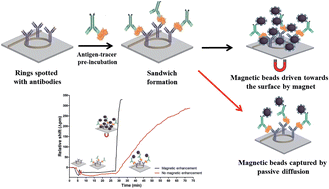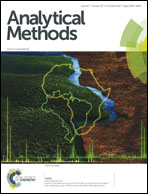Magnetically-actuated, bead-enhanced silicon photonic immunosensor†
Abstract
Magnetic actuation has been introduced to an optical immunosensor technology resulting in improvements in both rapidity and limit of detection for an assay quantitating low concentrations of a representative protein biomarker. For purposes of demonstration, an assay was designed for monocyte chemotactic protein 1 (MCP-1), a small cytokine which regulates migration and infiltration of monocytes and macrophages, and is an emerging biomarker for several diseases. The immunosensor is based on arrays of highly multiplexed silicon photonic microring resonators. A one-step sandwich immunoassay was performed and the signal was further enhanced through a tertiary recognition event between biotinylated tracer antibodies and streptavidin-coated magnetic beads. By integrating a magnet under the sensor chip, magnetic beads were rapidly directed towards the sensor surface resulting in improved assay performance metrics. Notably, the time required in the bead binding step was reduced by a factor of 11 (4 vs. 45 min), leading to an overall decrease in assay time from 73 min to 32 min. The magnetically-actuated assay also lowered the limit of detection (LOD) for MCP-1 from 124 pg mL−1 down to 57 pg mL−1. In sum, the addition of magnetic actuation into bead-enhanced sandwich assays on a silicon photonic biosensor platform might facilitate improved detection of biomarkers in point-of-care diagnostics settings.


 Please wait while we load your content...
Please wait while we load your content...